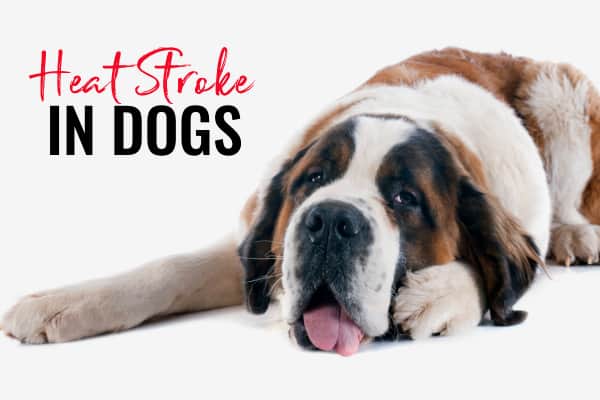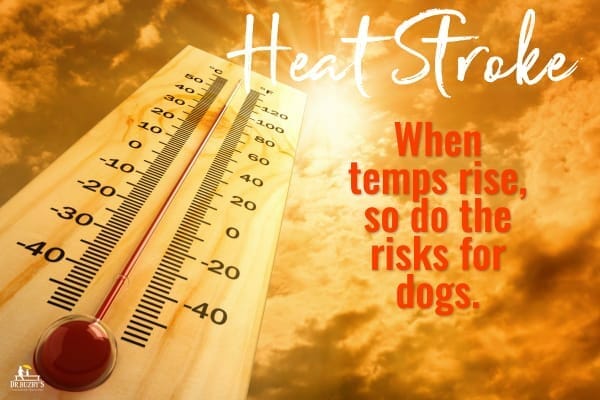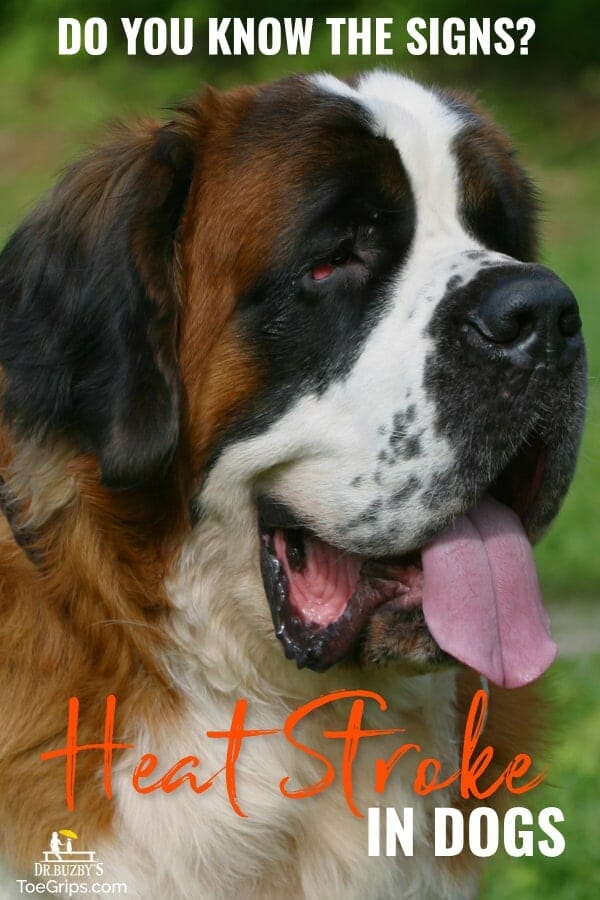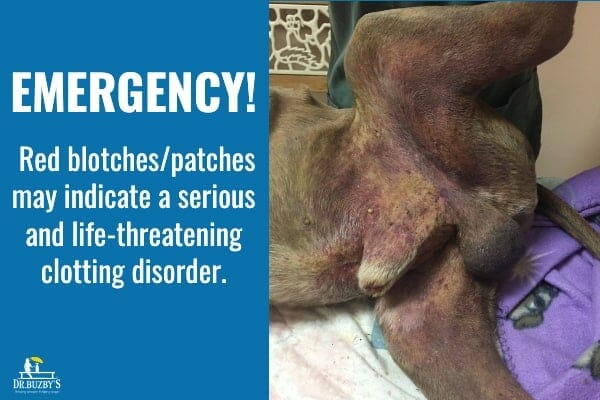Heat stroke in dogs is a life-threatening emergency, and one that is often preventable. Especially when temperatures rise and the humidity climbs, it is important to know how to recognize heat stroke and what to do if your dog shows signs of heat stroke. Integrative veterinarian Dr. Julie Buzby explains the symptoms, diagnosis, and treatment for heat stroke. Plus, she shares some important tips for preventing heat stroke.

As a veterinarian, a common misconception I’ve seen, especially on social media, is that it is easy to treat heat stroke with some IV fluids and veterinary outpatient care. This oversimplifies the condition and underestimates its severity.
Dogs who have experienced heat stroke will likely need hospitalization for aggressive and expensive treatment. And some of the serious complications of heat stroke will not manifest until after the initial episode, so the veterinarian must closely monitor the dog from initial onset through recovery.
Let me guide you through everything you need to know about heatstroke in dogs, so you’ll be prepped when the temperatures rise.
What is heat stroke in dogs?
Heat stroke in dogs is a potentially fatal condition which occurs when the body’s normal heat dissipating mechanisms become overwhelmed, causing the dog’s internal temperature to rise above 105°F (normal temperature for dogs is 99-102.5°F). Especially when the dog’s temperature hits 107-109°F, heat stroke can cause significant and life-threatening damage to multiple organs in the body.
We will talk more about how the body regulates temperature and why heat stroke is so dangerous. But first, I want to address the symptoms of heat stroke so you know how to recognize it and what to do if your dog might have heat stroke.

What are the signs and symptoms of heat stroke in dogs?
When a dog is suffering from heat stroke, you may see the following signs:
- Heavy panting
- Excessive drooling with thick saliva
- Blue, brown, pale, or red gums in dogs
- Vomiting and/or diarrhea (which may be bloody)
- Altered mentation (i.e. the dog acts dazed or confused)
- Seizures in dogs
- Ataxia or stumbling gait (i.e. the dog is wobbly and off balance)
- Collapse or inability to stand
- Being a lethargic dog
- Red or purple patches on the skin and mucous membranes (i.e. bruising and skin discoloration)
Prior to seeing these clinical signs, you may notice warning signals that your dog is becoming overheated or suffering from heat exhaustion(the steps before heat stroke). With those conditions, the dog may be panting heavily, looking for a cool place to lie down, or acting tired. But the symptoms will be much more mild than those of heat stroke. And dogs who are overheated or have heat exhaustion will not have neurologic changes (e.g. seizures or confusion), bleeding (e.g. bruising or bloody vomit or diarrhea), or collapse.
What should you do if your dog might have heat stroke?
Before we go any deeper into this article, let me stop here for a PSA:
If you think your dog may be developing signs of heat stroke, wet your dog with cool (not cold) water and immediately drive to the vet with the air-conditioning on full blast (or the windows open). It is critical that you make an emergency vet visit ASAP because time is of the essence when it comes to treating heat stroke.
Can you treat heat stroke in dogs at home?
To ensure I’m perfectly clear, I want to say again that the best, and really the only, place your dog should get treatment for heat stroke is at a veterinary clinic. If the dog truly has heat stroke, it is dangerous to try to treat him or her at home. All you should do is quickly take measures to cool your dog off (like misting him or her with cool water) and then head directly to the vet clinic.

Remember—never submerge your dog in an ice bath or use ice water to cool your dog down. Doing so sends the hot blood away from the skin and to the dog’s internal organs, which can increase the chances of organ damage. And especially if your dog is having bloody diarrhea or vomit, seizures (because yes, heat stroke can cause seizures in dogs), or showing other neurologic signs, your dog needs veterinary help ASAP. Do not wait around to see if your dog gets better at home.
The only time you should attempt home treatment for heat-related illnesses is if you are confident you are only seeing signs of mild overheating or heat exhaustion. But heat stroke signs are an automatic “Go to the ER now!”
Why does heat stroke occur?
When it comes to heat stroke, there are two main types—exertional heat stroke and non-exertional heat stroke.
Exertional heat stroke
As the name would indicate, exertional heat stroke occurs when the dog is exercising, usually in warm and/or humid weather. Most dogs love to play outside. However, they aren’t always the best at knowing their own limits. If a dog owner misses the warning signs of their dog overheating, even a summer game of fetch or frisbee can go from fun to dangerous rather quickly.
Non-exertional heat stroke
Also called “classic heat stroke,” non-exertional heat stroke occurs when a dog is trapped in an environment that doesn’t allow him or her to get rid of heat adequately. The most common cause of non-exertional heat stroke is leaving a dog alone in a parked car. However, it can also happen when a dog is confined to a yard with no shade or water.

How does the dog’s body normally regulate temperature?
Heatstroke is a problem because the canine body, just like the human body, is calibrated to function at a very specific temperature range. A normal temperature for a dog is between 99 to 102.5 degrees Fahrenheit. A small part of the brain, the hypothalamus, is responsible for controlling the body temperature.
Both internal factors (bacterial and viral infections, for instance) and external factors (ambient temperature) can affect a dog’s body temperature.
When a dog has a fever, the hypothalamus has reset the normal body temperature to a higher point. That’s why cooling a dog with a fever doesn’t actually help the fever. If you cool a dog with a fever, you bring the temperature down below what the hypothalamus has set as normal, and shivering sets in. Shivering is a compensation method to produce heat and bring the body temperature back up to the “new” normal.
In contrast, external factors do NOT reset the hypothalamus. A dog’s elevated temperature due to a hot environment is called hyperthermia rather than a fever. The dog’s temperature climbs and climbs, causing significant damage to the body. This is the case because all of the organ systems run smoothest at the normal temperature range.
The dog’s body can tolerate fever for quite some time and even overheating. It has built-in compensation methods to get rid of excess heat. But once the body’s temperature exceeds around 108-109° F, a dog’s body systems begin to break down. This is when heat stroke becomes very serious!
Dogs rely on cooling mechanisms to get rid of excess heat from the environment
Let’s take a look at some of the body’s cooling mechanisms and how they can become overwhelmed. Unlike people, dogs don’t have sweat glands throughout their bodies, so sweating is not an efficient means of cooling for canines. (Dogs sweat very little and only through their footpads.) Instead, dogs rely on evaporation and convection to regulate their body temperatures.
Evaporation occurs when dogs pant. Thus, one of the first signs of heat exhaustion in dogs is rapid, heavy panting.
Convection cooling occurs when a dog seeks a cold surface (i.e. a cool floor) on which to rest, thus transferring heat from the dog’s body to that surface. In cases where there is no mechanism to lower the body temperature (such as a dog left in a car on a warm day), heat stroke can occur quickly.
Which dogs are prone to heat stroke?
There are certain types and breeds of dogs that are more prone to developing heatstroke than others because of factors that hinder the efficacy of these cooling mechanisms. If your dog falls into any of these categories, please take heed:
- Overweight dogs—Overweight dogs can overheat rapidly. This is because the excess body fat acts as an insulator and traps heat within the body.
- Older dogs
- Boxers, Bulldogs, and other dogs with “flat” faces (brachycephalic breeds)
- Dogs suffering laryngeal paralysis or collapsed trachea in dogs
- Thick-coated dogs—Arctic breeds, such as Huskies and Malamutes, are not suited to hot environments. Yet they are frequently seen in places such as the deep South.

Why brachycephalic breeds have a harder time cooling themselves
While it may seem obvious that overweight and heavily-coated dogs are at higher risk for heat stroke, you may be wondering why brachycephalic dogs are on the list above. As explained, dogs rely heavily on evaporation (e.g. panting) for temperature regulation. Anything that impacts a dog’s ability to breathe impacts his or her ability to transfer heat.
Most dogs have relatively long snouts, and their nasal passages are highly vascular. This helps with their super sensitive sense of smell, but it also allows for temperature exchange. Dogs with short noses such as Pugs and Bulldogs have less space for this transfer to occur, and therefore have a harder time cooling themselves via panting. Thus, it is especially important to make sure your brachycephalic dog doesn’t overexert in the warmer weather.
What does heat stroke look like in a dog?
Heat stroke affects every single system in a dog’s body. But what is actually happening?
As an example, let’s look at a dog left in a hot car. The temperature inside the car is initially tolerable, but then it quickly begins to go up. To try to cool down, the dog starts to pant and seeks a cool place to lie down. There is no cool place, and the panting gets faster and faster but cannot effectively bring down body temperature. The blood vessels supplying blood flow to skin dilate, another mechanism for cooling. This pulls blood to the skin and away from the core.
Soon the downward spiral begins. The dog’s central blood pressure starts to drop. So the dog’s body compensates by increasing output of blood from the heart. The body does this by speeding up the heart rate. However, due to the high ambient temperature, the dog’s body cannot continue to compensate, and it becomes overwhelmed.
Once the temperature is 108-109°F, the dog’s body systems shut down quickly. Heat stroke and resultant organ failure can occur in a matter of minutes.

Effects of heat stroke on the brain
With the changes that occur due to heat stroke, the brain may not get enough blood (and therefore oxygen). And the dog may have swelling, bleeding, or clots in the brain. As a result, he or she may have seizures or altered mentation.
Effects of heat stroke on the GI tract
As a consequence of heat stroke, the cells lining the stomach and small intestines start to die. This is a problem for two reasons. First, that lining is critical in maintaining a barrier between the intestines (full of bacteria) and the bloodstream (sterile—no bacteria!). Second, absorption of nutrients through the gut is critical.
When those cells are damaged by heat, nausea and bloody diarrhea often result. And as the barrier breaks down, bacteria can enter the bloodstream. This leads to life-threatening systemic infection called sepsis or septicemia.
Effects of heat stroke on the kidneys
Heatstroke can also lead to acute kidney injury and therefore acute kidney failure in dogs. This occurs due to a lack of adequate blood supply to the kidneys, direct injury from the elevated temperature, or as a consequence of other changes that accompany heat stroke.
Effects of heat stroke on the heart and lungs
Thermal injury (i.e. heat injury) to the heart can cause bleeding and cell death. And the dog may develop abnormal heart rhythms. In fact, up to 25% of dogs with heat stroke will develop an arrythmia. Additionally, heat stroke can cause fluid to accumulate in the lungs (i.e. pulmonary edema) or lead to bleeding within the lungs.
Effects of heat stroke on blood clotting
Once body temperature reaches 109°F, the blood clotting system in the body starts to break down. Clotting factors are made in the liver. Like the rest of the body, they are sensitive to internal temperature. At 109°F, clotting factors no longer function. Plus, the platelets may clump together. All these changes can lead to a condition called disseminated intravascular coagulation (DIC).
Red spots on the dog’s skin—called petechiae—are one of the earliest manifestations of clotting problems. As they spread and merge into large patches, they are called ecchymotic hemorrhages. The image below shows what these large, red patches may look like.

What is the treatment for heat stroke?
Treatment for heat stroke in dogs is not as straightforward as just lowering body temperature. As discussed, once a dog’s body temperature gets above 108-109°F, organ damage and failure is imminent. That concern has to be addressed before a dog can be considered out of the woods. So the veterinary staff will work methodically and take multiple steps to treat heat stroke.
Your veterinarian will cool your dog down
Yes, cooling is certainly part of the treatment plan for heat stroke in dogs. That being said, there is some controversy in the veterinary community with regard to the best method for cooling. Generally speaking, especially for dogs with thick coats, I will wet their fur with cool water (and shave the fur if necessary) and place them on a cool metal table.
During the cooling process, it is critical to keep an eye on body temperature, and to stop cooling when the dog’s temperature reaches 103.5°F. If cooling is too aggressive, then a rebound hypothermia will occur, and the dog’s body temperature will be too low.
IV fluids
The next step in treatment after starting to cool a dog off is to start IV fluids. Fluid therapy serves several purposes in this scenario:
- IV fluids, which are room-temperature, not body temperature, can help cool the dog off.
- A dog having a heat stroke is in shock. This means blood pressure is low, heart rate is high, and circulation is poor. With poor circulation, oxygen delivery to tissue is decreased. Oxygen is essential for normal body function, so IV fluids can help promote circulation.
- Heat stroke in dogs can also cause issues with kidney function. Administering IV fluids helps to support kidney health.
- Dogs experiencing heat stroke may have electrolyte imbalances. IV fluids are balanced electrolyte solutions, so they can keep electrolytes more stable while the dog’s body focuses on recovery.
Oxygen therapy
Oxygen therapy is also important when treating heat stroke in dogs. When the circulatory system is struggling to get oxygen to tissues, your veterinarian can help it out by increasing the amount of oxygen the patient is breathing. That maximizes efficiency of every heart beat, pumping higher oxygenated blood to the tissues, which takes some of the stress off the heart.
Medications to treat symptoms like diarrhea, vomiting, and life-threatening infections
Many dogs with heat stroke exhibit signs of nausea—the dog may keep licking his or her lips, retching, and drooling. Plus, as mentioned earlier, the gastrointestinal tract cells are extremely sensitive to heat damage, so vomiting and diarrhea are common signs of heat stroke.
To help treat these symptoms and protect the GI tract, the vet may use anti-nausea medications like Cerenia for dogs and acid-reducers like omeprazole for dogs. Plus, the vet may administer antibiotics to address the potential for sepsis due to bacteria leaking out of the damaged GI tract.
Treatment of severe heat stroke in dogs
In some instances, organ and tissue damage is severe, and beyond the scope of treatment in a typical general practice. Your regular veterinarian may stabilize your dog, and then recommend transferring him or her to a 24-hour referral hospital for intensive care for heat stroke in dogs.
For example, as we discussed earlier, dogs with heatstroke can develop clotting issues and life-threatening DIC. In this situation, the dog needs a plasma transfusion because plasma, a component of blood, contains important proteins including clotting factors.
However, most general practices do not keep plasma on hand. It is expensive and requires specific storage and handling, so it is generally only available in pet ERs and ICUs. Dogs with abnormal clotting who are unable to receive a plasma transfusion in a timely manner are at risk of death. Thus, the best plan is to transfer them to a 24-hour emergency facility for a plasma transfusion.
What does recovery from heat stroke in dogs involve?
After initially stabilizing your dog, your vet or the veterinary ER will need to carefully monitor your dog for any additional complications. This is important because not all effects of heat stroke are immediately evident. Dogs may develop kidney failure, clotting issues, or other heat stroke-related problems during the hours or days following heat stroke. For this reason, dogs with heat stroke may end up being hospitalized for one to six days on average.
Monitoring usually involves carefully watching the dog’s temperature, pulse, respiratory rate, and mucous membrane color. Plus, the dog may need an ECG and blood pressure measurements frequently. And the vet may want to run blood tests for dogs to monitor the dog’s kidney parameters, electrolytes, clotting factors, blood glucose, red blood cell and protein levels, and more.
What is the prognosis for dogs with heat stroke?
Unfortunately, heat stroke is very dangerous and also expensive to treat. In a study of 54 cases of heat stroke in dogs, the mortality rate was 50%. Dogs were more likely to die or be euthanized due to heat stroke if they had clotting issues (including DIC), low blood sugar, or acute kidney injury. Additionally, a delay in treatment of over 90 minutes after the onset of heat stroke, being obese, or having seizures negatively affected the outcome.
How to prevent heat stroke in dogs: 7 important tips
Whether or not your dog is prone to heat stroke and falls into one of the at-risk categories outlined above, there are things you can do to keep your dog safe in hot weather. Here are seven helpful tips to keep your dog cool in the summer (and safe and happy too).

1. Do not exercise at-risk dogs in the heat
In the summer, at-risk dogs should NEVER be exercised in the heat. Walks should be in the early morning, before the heat of the day, and at twilight or after dark.
2. Bring dogs inside on hot days
It goes without saying that dogs kept outside in the summer should always have access to shade and fresh, cold water. But, seriously, dogs living in hot climates need to be brought indoors where they can cool off!
3. Don’t leave your dog in the car unattended
Never, never leave a dog confined in a car with the windows rolled up. Truthfully, it is safest never to leave dogs in parked cars, even with the air conditioner running. Recently, a colleague reported a client leaving two of their dogs in a running RV with the air conditioner blasting. They left for a few hours, and when they returned, the A/C had failed. Both dogs suffered heat stroke, and only one survived. Air conditioners break! It is always best to leave your dogs at home when running errands, unless you are visiting dog-friendly establishments.
4. Know your dog’s limitations
By simply keeping your dog cool, not exposing him or her to hot or humid conditions, and knowing your dog’s limitations, heat stroke is preventable. When in doubt, the best approach is to keep your canine companion safely at home in the air conditioning with access to water (ideally fresh cool water)!
5. If your dog suffers from laryngeal paralysis or other respiratory conditions, be especially vigilant
Conditions like laryngeal paralysis in dogs or tracheal collapse can make dogs uniquely prone to heat stroke. This occurs because of upper airway obstruction. Since they cannot pant well and ventilate appropriately, they quickly become distressed. This is one of the most common reasons for a dog to have a heat stroke, second only to being left in a hot car.
6. Protect your dog’s paws from the heat too
Don’t forget to protect your dog’s paw pads. On a hot day, the temperature of pavement is significantly higher than air temperature. Hot pavement can cause severe paw pad injuries in dogs. If the pavement is too hot for you to comfortably touch with your bare hands, it’s too hot for your dog to walk on! Keep your pup indoors or on unpaved surfaces for outdoor excursions.
7. Know how to cool down an overheated dog
If your dog is starting to become overheated or is suffering from heat exhaustion (the stages before heat stroke), it is important to recognize the signs and take measures to help cool down your dog. This may involve taking a break and coming inside, offering your dog water, turning on a fan or turning up the A/C, or wetting your dog down with a hose. (PSA- If you plan to let your dog play in the water from a hose, let it run a bit first and check the temperature. Water that sits in a hose in the sun can reach scalding temperatures and burn your dog.)
Ideally, taking these steps will help your dog avoid heat stroke. But if you aren’t sure if you are seeing signs of heat stroke vs heat exhaustion in dogs, it is always best to visit your vet ASAP. And if you are pretty sure your dog has heat stroke, don’t waste time wondering, should I take my dog to the emergency vet? Just go!

A Saint Bernard dog collapses from heat stroke
Finally, I’d like to share the story of a Saint Bernard named Charles. He was the first dog that I ever treated for heat stroke. Of course, I’d studied heat stroke in veterinary school. But studying about it in a textbook and seeing the suffering dog lying before me on a gurney were quite different.
It was July in the South. Need I say more? Picture humidity so thick that the mosquitoes were choking.
One of my favorite patients, Charles, was boarding at a local doggy daycare. He’d been outside, in the 90+ degree heat, frolicking with his friends when he’d suddenly collapsed.
The boarding facility called in a panic, letting us know they were bringing Charles straight in. I prepared my staff for his arrival.
Veterinary treatment
When he arrived, Charles couldn’t walk. He looked melted in the back of the SUV, panting so heavily that I couldn’t understand how he was able to ventilate himself. His tongue lolled out to the side, and his eyes were panicked. I could feel the heat radiating from his body.
My staff jumped into action by carefully lifting him onto a stretcher and bringing him into the hospital. One vet tech began shaving Charles for an IV catheter to start cool intravenous fluids while the other technician took the St. Bernard’s temperature and got his heart rate. (As an aside, knowing your dog’s vital signs just might save his or her life someday. Please learn how to assess dog vital signs and take your dog’s temperature.)
The St. Bernard’s temperature was an astounding 111°F.
My hospital doesn’t have overnight care, so our goal was to stabilize Charles before transferring him to the local 24-hour specialty veterinary hospital. He would need days of critical care. Even with all that modern veterinary medicine has to offer, his prognosis (expected outcome) was “guarded.”
Our veterinary team started by cooling him with water, and a fan. Next, we placed an IV catheter and started IV fluids. Then, we lined an oxygen mask with ice to deliver cooled oxygen.
Diagnostic testing
When Charles first arrived and we placed the IV catheter, my forward-thinking technical staff had obtained blood samples right away. We ran two tests on the in-house bloodwork machines—a complete blood count (CBC) and a chemistry panel. A complete blood count is exactly what it sounds like! The blood components—red and white blood cells and platelets are counted.
In dogs with heat stroke, alterations in these numbers happen fast. As expected, my patient’s platelets were low (the first step in the clotting cascade discussed above), and his white blood cell count had fallen as well. This is because of heat damage to the bone marrow, where those cells originate, but also because of the body’s overwhelming inflammatory response to heat stroke “tying up” those cells.
A chemistry panel evaluates the organs and electrolytes. Already, the St. Bernard had alterations in his kidney values—BUN and creatinine (elevated)—and his liver enzymes. His blood sugar was also dangerously low at 50 (normal range is 75-120). All of these changes are to be expected in dogs with heat stroke, as every organ in the body is damaged. Electrolytes (like sodium and potassium) can also be deranged, although my patient’s were normal.
I added dextrose, a synthetic sugar, to his IV fluids to bring his blood sugar back to normal. His temperature was down to 103°F, and my technicians had removed the fan. It was time to transfer him to the referral hospital.

One dog’s full recovery from heat stroke
I strive to tell you stories of hope and happy endings, and my St. Bernard patient is one of those stories. Under our care and then the care of a 24-hour hospital, he survived. He received three units of fresh frozen plasma and remained hospitalized for five days on IV fluids, antibiotics, and GI protectant medications for his damaged gastrointestinal tract. His blood sugar levels fluctuated, and he needed dextrose supplementation to fuel his cells. With this aggressive and high-level care, it was no surprise his veterinary bill for the incident was several thousand dollars.
But he could have died, and it’s a miracle that he didn’t.
Heat stroke in dogs is preventable
There are two uplifting takeaways here: my St. Bernard patient survived AND heat stroke (in all but the rarest cases) is absolutely preventable. When the temperatures rise, there’s no need to risk it. Preventing heat stroke means avoiding risky situations in the first place, being mindful of your dog’s limitations, and knowing whether your dog is prone to heat stroke.
As you’re enjoying upcoming summer activities, please share this article to help educate other dog parents. With knowledge and information, we won’t need a stroke of luck to prevent heat stroke in dogs.
What questions do you have about heat stroke in dogs?
Please comment below.


Is it possible for a puppy to have heat stroke with just panting and tiredness. I had my 10 week lab in his crate in the back of my forester so not a big SUV. I had the air-conditioner blasting but when I took him out with me to run into the store he was panting and seemed tired. It did seem warm in the back of the car so I am worried. He is usually happy to run into the pet store with me. There was no vomiting or diarrhea and when he got home he drank and was very playful.
Hi Dori,
I understand your concern for your puppy and think it is great you are paying such close attention to his behavior. With what you describe, he may have experienced a bit of heat exhaustion (early stages) but with no other symptoms I would not classify this as true heat stroke. I am glad you were able to intervene quickly before things progressed any further. Wishing you all the best and keep up the good work!
thank you for the beneficial information..my puppy suddenly panting after coming home from a walk..I don’t know if he have heat stroke..all the symptoms persist but except having bloody diarrhea or bloody vomiting..is there any chance that he can survive? though he had eat the food that I gave to him..even drink more lukewarm water after heatstroke, am I should worry bout it? or is it in a good condition?
Hi Cresna,
I understand your concern for your puppy since he is displaying these worrisome symptoms. Without being able to examine him myself, I can’t make specific conclusions or tell you if this is life threatening. Please take your puppy to your vet and allow them to evaluate his condition. If they have any concerns, they can start the appropriate treatment and try to get things under control. Hoping this is nothing serious and your sweet boy will be ok. Best wishes to you both.
Thank you so much for your informative articles. My border collie competes in agility trials. I have seen some dogs with cooling jackets pre and post run. The jackets seem to be made of chamois like material which holds water that evaporates throughout the day. What are your thoughts?
Hi Darlene,
Cooling jackets sound like a great way to try and avoid heat exhaustion in these high-performance dog athletes. What a great idea! Thanks for sharing.
My yorkie is 15. Left in car at 82 with windows 1/3 down in shade for 35 min. She was panting. I thought was anxiety from leaving her. Got to vet 3 days later. Vet don’t know. I think my yorkie has stress, heat stroke. In the morning she’s normal 10 minutes then legs collapse, she shivers then pants. I gave pain pill. Hour later like normal. 6 hours later, suddenly can’t stand, paws fold under, no strength. Will she get better? She a very healthy and vibrant dog.
Thanks
Hi Jeannette,
I am very concerned about the worrisome symptoms you are describing in your senior pup. Since I haven’t examined your dog myself, it is difficult to make specific conclusions and recommendations. I am suspicious about heat stroke and its lingering effects, but also curious about a possible neurological issue. It might be a good idea to have your little girl evaluated by a veterinary neurologist. Did you allow your vet to do any diagnostic testing? I hope you can get some answers and help restore your girl’s quality of life. Praying she is well and resting comfortably today.